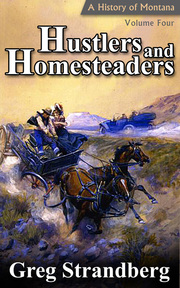 On Sale Now
On Sale Now We’re talking monumental western fires, the creation of the U.S. Forest Service, the first huge dams in the state, the largest population increase we’ve ever seen, and the calamities that’d set our demographics in stone until today.
I’ve profiled many of the history books of Montana on this site, and I always make it a point to say that most end where the 20th century begins. I made that point when I started writing this history of Montana in March 2013 when I was still living in China.
Oh how I looked forward to the day when I could get into our modern times and understand what makes our state tick...and now we’re here!
So what does that look like, Montana’s entry into the 1900s? Take a look at the book’s Table of Contents:
Part I – The 1900s
- “Remember the Maine, To Hell with Spain!”
- Montana’s Buffalo Soldiers
- Montana in the Philippine-American War
- Roosevelt, Yancey and the Yellowstone Arch
- The Building of the Capitol
- Montana Politics in the 1900s
- Montana and the National Forests
- Homesteading in the West
- Damming the State
- Reclaiming the Land
- The Panic of 1907
Part II – The 1910s
- The Big Burn
- Homesteaders Flock to Montana
- Cattlemen and Their Ranches
- Early Automobiles in the State
- Montana Politics in the 1910s
- The Conflict with Mexico
- The Politics of War
- Montana and World War I
- The 1918 Flu Pandemic
Part III – The 1920s
- The Farming Crisis
- The Banking Crisis
- County Splitting and Its Consequences
- Montana Politics in the 1920s
- The 1924 Democratic Split
- Anaconda Goes South
- The Start of Oil & Gas in Montana
Conclusion
Endnotes
Bibliography
About the Author
By the 1910s we get into the history of homesteading in Montana. Hardly anyone today can imagine what homesteading was like just 100 years ago.
The ability to work for oneself all day and keep all of the proceeds appealed to a self-determinist nature that was embedded into the mindset of the nation from its youngest days. That mindset was strong in those that came to Montana, and they came with hopes and dreams…and most of all, determination.
Many failed, it’s true, but many succeeded as well, fighting for an existence and beating it from the hardscrabble earth around them. They often came with nothing and started with little more, but they worked hard and found success. Families grew strong as they worked together and neighbors became friends as social ties built upon reliance grew. It was their land and they knew it, and they meant to make something of it by God, even if it killed them trying. And they did.
Despite the losses and the hardships and the great exodus of nearly a quarter million people in just two years, people stayed and became Montanans in the process. They earned the right to call themselves that because they worked for it, and they worked hard.
How Montana Leads the Nation
Montana voted to give women the right to vote as far back as 1889, and it came close to passing too, losing by just five votes, 29-34. That didn’t stop the momentum, and less than twenty years later the first woman ever elected to a national parliamentary body in the world came from Montana, in 1917.
Jeanette Rankin would be but one of fifty that voted against American entry into WWI, a vote that was lost 373 to 50, with 9 abstentions. She was the only member of Congress to vote against entering WWII when she was again elected in 1940.
The agricultural methods pioneered in the West and tested in Montana led to national New Deal programs under the calm and clear-headed guidance of Milburn L. Wilson, allowing the world to be fed.
Montana was the first place in the world to give workers the eight-hour day and did so in 1900, sixteen years before such happened nationally under the Adamson Act, and then only for railroad workers. Montana passed the first law giving old-age pensions in 1923, twelve years before such a thing happened nationally with the Social Security Act of 1935.
Montanans led the way into war as well, dying in greater numbers per capita than any other state, something she can both proudly and sadly claim going all the way back to the Spanish-American War of 1898. A total of 943 were killed in WWI and 317 died in WWII. Korea took 134 while Vietnam took 267. Operation Desert Storm took Mark R. Cronquist of Columbia Falls. The dual wars in Iraq and Afghanistan have taken 43…so far.
So where does our journey take us next? Into the 1930s and right up to the election of 1960…but that’ll be for Volume Five of this history. Until then, enjoy Hustlers and Homesteaders on Amazon, iTunes, Barnes & Noble, Createspace, Smashwords, and other places I don't know.





